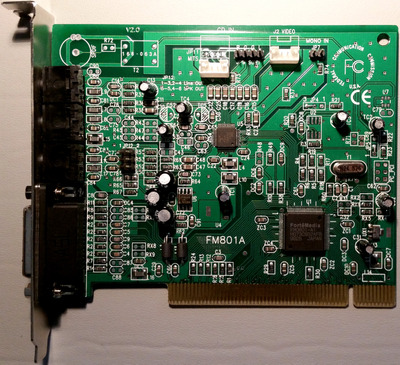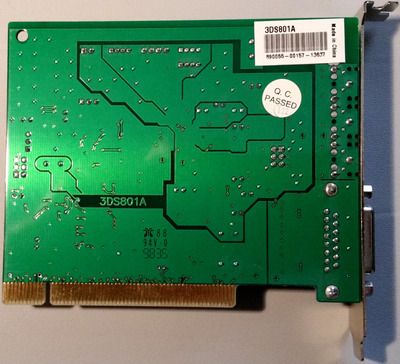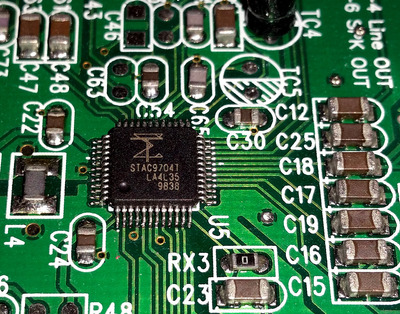First post, by doshea
- Rank
- Member
Here are my experiences with Sound Blaster emulation in DOS with some kind of generic FM801 clone I picked up in case they are useful to anyone else.
I tested this on an MSI "PM8M-V H"/"MS-7104 ver 3.0" motherboard with a VIA P4M800 + VT8237R Plus chipset. The BIOS offered no way to explicitly assign IRQs to slots, but I found that if I disabled many of the onboard devices in the BIOS settings and put the card in the slot furthest from the CPU it was assigned IRQ 5.
The board is labeled both "3DS801A" and "FM801A". I haven't been able to figure out who manufactured it.
My transcription of what is on the main chip:
ForteMediaFM0801-A1HG73C502AFB9825 JAPAN
I note that it has pads for a 6-pin PC_PCI header.
The AC'97 codec chip which can't be identified properly from the photos above is a STAC9704T:
When I booted up Knoppix 7.2 (Linux) on it, it identified it as a "ForteMedia Xwave QS3000A" on the console during startup, and /proc/asound/cards says it is an "FM801-AS".
I couldn't get any audio output either in Knoppix or DOS, and eventually realised it needed some jumpers on JP12 (which is very close to the audio output jack) to select between "Line OUT" and "SPK OUT", with instructions shown below "JP11 MITS".
The Dos202.zip drivers from https://web.archive.org/web/20000620232801/ht … port/driver.htm, which are the same as the contents of the "DOS v2.02" directory in http://vogonsdrivers.com/getfile.php?fileid=1147&menustate=0, and the DOS drivers in the "VXD Q3D v2.05f" directory of the latter both seem to work equally well. I used INSTALL.EXE from the former and then tested later by copying over the DOS .EXE files from the VXD directory without actually installing anything in Windows.
Test results:
Prince of Persia: Fine apart from hanging notes
Wolfenstein 3-D: Digital audio was distorted, as if it was playing too slowly, and the volume was perhaps dropping in the middle of playback. Adding the /1 parameter to CFG801.EXE's command line and/or not loading the DOS801.EXE TSR seemed to help with the volume dropping out but I think the sound still seemed to be playing too slowly.
DOOM 1.9: Fine
Microprose Grand Prix 2: Audio kept cutting out (for a fraction of a second every 5-15 seconds or so) until I added the /1 parameter to CFG801.EXE's command line. Edit: can set to either Sound Blaster or Sound Blaster Pro.
Issues with the DOS drivers:
A confusing aspect of the /<number> parameters to CFG801.EXE to select the mode is that the setting is written to DOSGAME.CFG as DOSMode=<number> so the setting persists: if you reboot and don't pass a /<number> parameter next time you run it, rather than go back to default it'll use the last value you passed! Passing /0 restores it to default (autodetection).
Adding the /T parameter to the CFG801.EXE command line causes it to indicate what PCI chipset it detected. In my case it said "Can't find PCI Chipset Device!" and that it was defaulting to legacy 2 mode, whereas as noted above it turned out that legacy 1 mode was better for me.
I'm not sure what the DOS801.EXE TSR is for. When I didn't load it, all those games still worked the same. Is it only for cases where the card isn't assigned to an appropriate IRQ by the BIOS and the TSR needs to redirect it?
Sorry about the bad lighting in the photos!








